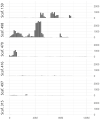A chromosomal-scale reference genome of the New World Screwworm, Cochliomyia hominivorax
- PMID: 36370138
- PMCID: PMC9835758
- DOI: 10.1093/dnares/dsac042
A chromosomal-scale reference genome of the New World Screwworm, Cochliomyia hominivorax
Abstract
The New World Screwworm, Cochliomyia hominivorax (Calliphoridae), is the most important myiasis-causing species in America. Screwworm myiasis is a zoonosis that can cause severe lesions in livestock, domesticated and wild animals, and occasionally in people. Beyond the sanitary problems associated with this species, these infestations negatively impact economic sectors, such as the cattle industry. Here, we present a chromosome-scale assembly of C. hominivorax's genome, organized in 6 chromosome-length and 515 unplaced scaffolds spanning 534 Mb. There was a clear correspondence between the D. melanogaster linkage groups A-E and the chromosomal-scale scaffolds. Chromosome quotient (CQ) analysis identified a single scaffold from the X chromosome that contains most of the orthologs of genes that are on the D. melanogaster fourth chromosome (linkage group F or dot chromosome). CQ analysis also identified potential X and Y unplaced scaffolds and genes. Y-linkage for selected regions was confirmed by PCR with male and female DNA. Some of the long chromosome-scale scaffolds include Y-linked sequences, suggesting misassembly of these regions. These resources will provide a basis for future studies aiming at understanding the biology and evolution of this devastating obligate parasite.
Keywords: Cochliomyia hominivorax; Calliphoridae; HiC genome; chromosomal assembly; ectoparasite.
© The Author(s) 2022. Published by Oxford University Press on behalf of Kazusa DNA Research Institute.
Figures






References
-
- Barros, G.P. and Bricarello, P.A.. 2020, Myiasis by Cochliomyia hominivorax (Coquerel, 1958): a neglected zoonosis in Brazil, Open J. Vet. Med., 10, 80–91.
-
- Wyss, J.H. 2000, Screwworm eradication in the Americas, Ann. N. Y. Acad. Sci., 916, 186–93. - PubMed
-
- Scott, M.J., Concha, C., Welch, J.B., Phillips, P.L. and Skoda, S.R.. 2017, Review of research advances in the screwworm eradication program over the past 25 years, Entomol. Exp. Appl., 164, 226–36.
-
- Hall, M. J. R. and Smith, K. G. V.. 1993, Diptera causing myiasis in man. In: Lane, R. P. and Crosskey, R. W. (eds), Medical insects and arachnids, Springer, Netherlands, Dordrecht, pp. 429–69.
MeSH terms
Grants and funding
LinkOut - more resources
Full Text Sources
Miscellaneous

